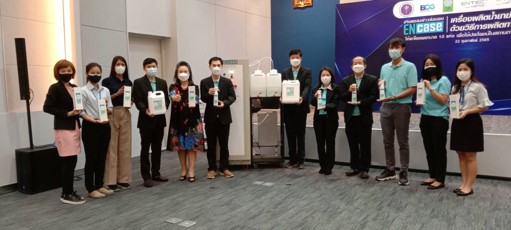

Background
Emerging infectious diseases have been a serious threat to public health due to the difficulty in control and prevention, in particular the recent outbreak of the coronavirus disease 2019 (Covid-19), which can be transmitted rapidly through the respiratory system and by physical contacts. One of the strategies to curb the spread of transmissable diseases is to use effective disinfectants to clean public areas and for use in the hospital.
Goal
To develop an electrolyte disinfectant generator that employs the principle of electrochemical reactions to convert sodium chloride (NaCl) solution to hypochlorous acid (HOCl) which is effective in killing bacteria, fungi, and SARS-CoV-2 virus. Target groups are hospitals, nursing homes, communities, the food industry, as well as animal farms to prevent infectious diseases in animals such as cholera and Streptococcus suis infection which leads to Sudden Hearing Loss (SHL).
How does the team do it?
- Design and develop a flow control device to ensure the energy saving process and increase productivity of the generator,
- Design and develop a production system to be more permissive to various forms of “salt”, while the disinfectant generator currently available in the market must use saline,
- Design and develop an electrolysis unit that produces disinfectant containing hypochlorous acid (HOCl) as the main component with at least 400 ppm chlorine content and suitable for a wide range of applications without being limited by a pH level or chlorine derivatives in the hypochlorite form (OCl-) which are limitations of current technology.

Research Prototype
An electrolyte disinfectant generator employing the principle of electrochemical reactions (ENCASE)
Research Status
With funding from the National Research Council of Thailand, ENcase machines have been manufactured and distributed to 10 hospitals in four provinces, namely, Phaholpolpayuhasena Hospital, Sisaket Hospital, Ban Phak Kha Sub-District Health Promotion Hospital, Warin Chamrap Hospital, Yang Chum Noi Hospital, Yang Chum Yai Sub-District Health Promotion Hospital, Mueang Chan Hospital, Non Khun Sub-District Health Promotion Hospital, Phato Hospital and Pak Nam Lang Suan Hospital.



Future Plan
To study factors affecting the production capacity, properties and efficacy of the disinfectant in order to design a machine that has at least 50L/hr production capacity with chlorine content higher than 200 ppm, oxidation-reduction potential (ORP) greater than 800 mV and pH between 4 and 7.
List of researchers
Dr. Somsak Supasitmongkol, Dr. Chaiyuth Saekung, Dr. Visarn Lilavivat, Dr. Sumittra Charojrochkul, Dr. Supakit Worasinchai, Dr. Thaneeya Roytrakul, Dr. Sittiruk Roytrakul and Mrs. Pattiyaa Laksanacharoen
Contact Person
Dr. Somsak Supasitmongkol
Low Carbon Energy Research Group
Tel: 02564 6500 ext 74700
E-mail somsak.sup@entec.or.th
